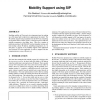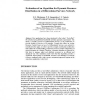143
Voted
HPN
1998
15 years 1 months ago
1998
: The attempt to provide QoS in IP networks has raised some interesting questions on how a service can be provided to meet the application requirements while obeying the network re...
112
Voted
MMNS
2003
15 years 1 months ago
2003
A growing interest in third generation wireless IP network and service technologies, push up the demand on IPv6 transition. Most of these services require mobility, multicast and m...
100
click to vote
ICC
2007
IEEE
15 years 4 months ago
2007
IEEE
Abstract-- Recovery of traffic in connectionless pure IP networks has traditionally been handled by a full re-convergence of the network state. This process operates in a time scal...
114
Voted
WOWMOM
1999
ACM
15 years 4 months ago
1999
ACM
Enabling mobility in IP networks is an important issue for making use of the many light-weight devices appearing at the market. The IP mobility support being standardized in the I...
112
click to vote
ICN
2001
Springer
15 years 4 months ago
2001
Springer
New applications have been introduced to the today’s “best-effort” IP networks having different bandwidth and delay guarantee requirements. The IETF is currently focused on D...
124
click to vote
ICN
2005
Springer
15 years 6 months ago
2005
Springer
Abstract. The Reliable Server Pooling (RSerPool) protocol suite currently under standardization by the IETF is designed to build systems providing highly available services by prov...
MINENET
2005
ACM
15 years 6 months ago
2005
ACM
Faults in an IP network have various causes such as the failure of one or more routers at the IP layer, fiber-cuts, failure of physical elements at the optical layer, or extraneo...
138
Voted
INFOCOM
2005
IEEE
15 years 6 months ago
2005
IEEE
— With the emergence of Voice over IP and other real-time business applications, there is a growing demand for an IP network with high service availability. Unfortunately, in tod...
117
click to vote
SECURWARE
2008
IEEE
15 years 6 months ago
2008
IEEE
—IP networks, composing the Internet, form a central part of the information infrastructure of the modern society. Integrated approaches to the assessment of their dependability ...



